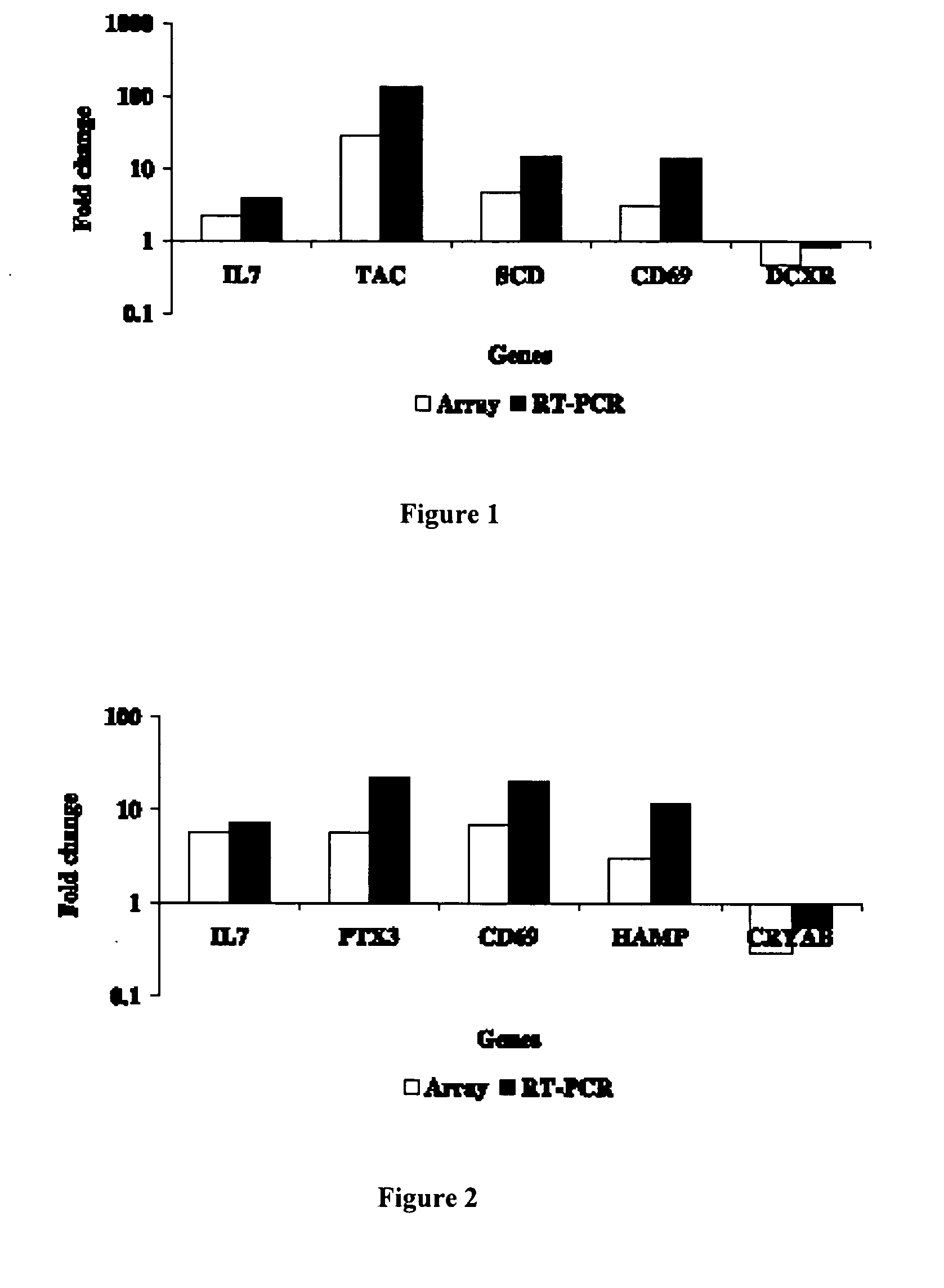Method for diagnosing peripheral neuropathy
a peripheral neuropathy and neuropathy technology, applied in the field of peripheral neuropathy, can solve the problems of difficult to distinguish vasculitic neuropathy, lack of reliable tests, and inability to diagnos
- Summary
- Abstract
- Description
- Claims
- Application Information
AI Technical Summary
Benefits of technology
Problems solved by technology
Method used
Image
Examples
example i
Patients and Methods
A. Patients
[0160] Nerve biopsies from eight patients with CIDP were included in the study. The diagnosis was based on clinical, pathological and electrophysiological criteria (Berger et al. (2003), supra). The characteristics of the CIDP patients and nerve biopsies are listed in Table 1. In addition, nerve biopsies of three patients with vasculitis representing an inflammatory nondemyelinating pathology were included; patients were diagnosed using conventional procedures. As normal controls, biopsy specimens were obtained from three individuals who did not suffer from polyneuropathy but from myopathy, muscular dystrophy and dermatomyositis, respectively.
TABLE 1CIDP patient dataAgeBiopsy timePatient(years)Sexafter onsetM / SCourseCSFEMGPathology149F72 monthsS > MRRn.a.SensorimotorSegmental demyelinationdemyelinatingand remyelination noinfiltrates. Muscle: mildneurogenic abnormalities254MSeveral yearsS > MProgressiven.d.Absent SNAP,Severe loss of large-normal mo...
example ii
Results of Gene Profiling Studies
A. Sample and Chip Quality
[0169] The yield of RNA varied from 100 ng to 2.9 μg per sample. The integrity of the RNA as seen by SYBR-Gold® staining after gel electrophoresis was intact and the ratio A260 / 280 as measure of the RNA purity on UV absorbance ranged for most of the samples from 1.79 to 2.06. Only 2 out of 14 samples had a lower A260 / 280 ratio which is probably due to the older age of the biopsy samples. The Chip quality was good with present calls between 30.5% to 60%. We also looked at the probe sets of specific maintenance genes (GAPDH, beta-actin) that are designed to the 3′, middle, and 5′ regions of the transcript and compared the 3′ probe set signal intensity to the 5′ probe set signal intensity (3′ / 5′ ratio) as a measure for RNA degradation and efficiency of transcription reaction. The 3′ / 5′ ratio for beta-actin was in most samples below 20 and only in the same 2 out of the 14 samples higher with 29.03 and 28.02 respectively. We a...
example iii
Expression of Substance P is Increased in CIDP Nerve
[0183] As shown in Example II, a study of gene expression profiles of CIDP nerve biopsies in comparison to normal controls, tachykinin precursor I was the most upregulated gene in CIDP, with a 27.8 fold increase in CIDP. One of the polypeptides encoded by the tachykinin precursor 1 gene is substance P. Substance P is an 11 amino acid peptide that is widely present in the peripheral and central nervous systems and is involved in transmission of pain, as well as other functions. To investigate and characterize the expression of substance P in CIDP nerve in comparison to normal nerve, we performed staining of histological samples, using conventional methods.
[0184] Formaldehyde-fixed and paraffin-embedded sections of human sural nerve biopsies were deparaffinized and rehydrated by sequential incubation in xylene, ethanol, and PBS. Antigen retrieval was done by incubation in trypsin and endogenous peroxidase was quenched with H2O2 in ...
PUM
| Property | Measurement | Unit |
|---|---|---|
| Fraction | aaaaa | aaaaa |
| Length | aaaaa | aaaaa |
| Time | aaaaa | aaaaa |
Abstract
Description
Claims
Application Information
 Login to View More
Login to View More - R&D
- Intellectual Property
- Life Sciences
- Materials
- Tech Scout
- Unparalleled Data Quality
- Higher Quality Content
- 60% Fewer Hallucinations
Browse by: Latest US Patents, China's latest patents, Technical Efficacy Thesaurus, Application Domain, Technology Topic, Popular Technical Reports.
© 2025 PatSnap. All rights reserved.Legal|Privacy policy|Modern Slavery Act Transparency Statement|Sitemap|About US| Contact US: help@patsnap.com



